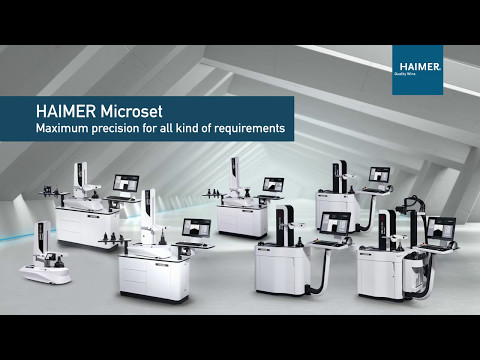How HAIMER Microset Presetting Technology Slashes CNC Setup Time
A HAIMER Microset presetter offers benefits from a reduction in setup time of as much as 70 percent to higher productivity, improved workpiece accuracy and longer tool life.
A HAIMER Microset presetter offers benefits from a reduction in setup time of as much as 70 percent to higher productivity, improved workpiece accuracy and longer tool life.
Before buying a machine-tool presetting device, small machine shops often view it as high-end equipment they can manage without, figuring that old-school manual setup has worked well enough so far.
Once they get one, however, they almost invariably wish they had made the purchase sooner, says Brendt Holden, president of Haimer USA.
And they regret the lost savings of time and money as they realize payoffs from their investment that include up to a 70 percent reduction in setup time, higher productivity, improved workpiece accuracy and longer tool life.
Presetters shorten setup time by gauging the dimensions of a tooling assembly—a cutting tool plus a holder—to ensure alignment with both the CNC machine that will use it and the workpieces it will cut and shape.
It’s a far more efficient process than determining coordinates by touching off, or connecting the assembly to the machine spindle to measure the height offset, something Holden himself did as a machinist at a small business in the early 1990s.
The time required for the manual process wasn’t always factored into price quotes for customers, he recalls, creating confusion about production timetables and masking the real cost of the job.
“With a presetter, we could have saved a lot of time and had the machine running more,” Holden says.

While presetters are particularly beneficial for small shops that have a high mix of low-volume job runs—since they have to set up machines more often—many of their operators still think of the devices as the domain of large production operations, Holden says.
Larger businesses do benefit from consistent production and setup, he adds, but presetters are “even more advantageous for the smaller shops.”
And even when setups aren’t handled offline, which translates to more machine “uptime,” using a tool presetter is significantly faster than either manual or laser setup, Haimer says.
There are other benefits, too. Measurements taken with a presetter’s optical cameras are far more accurate than manual setting methods, reducing scrap and prolonging tool life by avoiding the use of inaccurate assemblies.
And state-of-the-art data transmission methods, such as radio-frequency identification or RFID tags, reduce mishaps from typos that often occur when machinists have to manually enter offsets into CNC equipment.
At an operational level, the increased machine utilization made possible by HAIMER Microset’s UNO and VIO presetters help machining businesses make the best use of employee skills as the pool of manufacturing workers shrinks, Holden explains.
The devices also provide an introduction into automation, one that stops short of the robotics often associated with the term, he says.
“We always encourage customers to start small with automation,” Holden adds. “Presetters are an entry point because you’re making the process more automated on the back end, while the machine is running, as well as more consistent. That’s even more valuable with a growing shortage of skilled workers.”

The UNO series, the first of HAIMER Microset’s two lines brought to market, uses servo motors, has a cast-iron base and sits on a table. The newer VIO, which relies on linear motors, is about 25 percent faster.
Together, the two lines offer seven different models, which are operated with the company’s intuitive Microvision software that includes features such as macros for fast creation of automatic measuring sequences, a history of measured results and a template system to use with similar tool geometries.
It’s all designed in keeping with the company founder’s principle that when workers don’t know how to use equipment, they won’t use it.
“There are new people in the toolroom all the time, so you want to make sure they can pick up the technology quickly and will want to use it,” Holden says. “Both the software and the functionality of our presetting technology are constantly evolving, with functions that make it even easier to use,” he says.

HAIMER Microset presetters typically last 15 to 20 years, thanks to their solid construction, with return on investment beginning about six months after purchase. They’re designed to be compatible with customers’ existing machines.
Despite the advantages of presetting equipment, Holden says, it’s underutilized in much of the market. He estimates that only 30 percent of machine shops—at best—own a presetter.
Sales talks for the devices are often lengthy, he adds, with customers saying, “I’ve been touching off my tools forever, and I’ve been successful,” Holden explains. “And they have. But after about a month of owning one, when they realize what a difference it makes, they’re shocked that it took them so long.”



